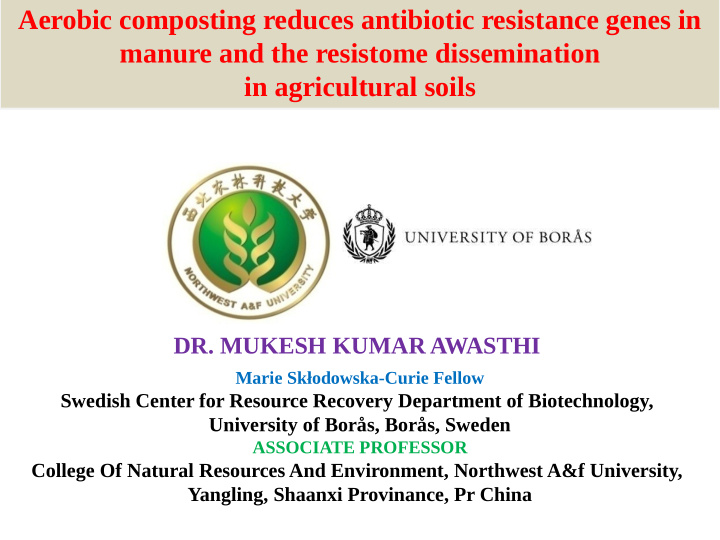



Aerobic composting reduces antibiotic resistance genes in manure and the resistome dissemination in agricultural soils DR. MUKESH KUMAR AWASTHI Marie Skłodowska-Curie Fellow Swedish Center for Resource Recovery Department of Biotechnology, University of Borås, Borås, Sweden ASSOCIATE PROFESSOR College Of Natural Resources And Environment, Northwest A&f University, Yangling, Shaanxi Provinance, Pr China
Contents • Livestock manure generation and antibiotic percentages • Problems and ecofriendly management to reduce the antibiotic resistant genes • How composting is better option to mitigate the antibiotic resistant genes. 2
Manure Generation In the last 5 year, the world population increased from 2.0 to 3.0 billion, but with the increasing demand for animal protein, pig production in China increased to about 0.58 billion in 2017 (Guo et al., 2018). The trend of increasing live stocks manure generation is higher in China compared to other Asian countries. Among the total waste generated from East Asia and Pacific region, up to 70 % waste is generated from China and India. Fig 1. General distribution of antibacterial ingredients sold in 2012 by Animal Health Fig 2. Tones of base active ingredient of each class of Institute Members in the United States for antimicrobials used in humans in the community in the UK veterinary use (Source: Animal Health Institute and hospitals in England and wales only and used in 2008). 3 animals in the UK in 2012.
Fate of antibiotics in the environment 5
Livestock Farming Status in China 3/7/2019 6
Livestock Farming Status in China Source: China Statistical Yearbook ( based on slaughter) • 3/7/2019 6
Livestock Farming Status in China With rapid development of the livestock industry, the production of manure increased year by year. b Amounts of manure /hundred million a a (pig equivalent) Year Fig. 3 Amounts (a) of livestock manure in China during 1978 to 2011, and cropland load of manures in 2011 (b) Source: Zhu et al., 7 2014. 3/7/2019
3/7/2019 8
Nutrient And Pollutant Contents in Livestock Manure A . The nutrient contents in livestock manure Category N(%) P 2 O 5 (%) K 2 O(%) Cu(mg/kg) Zn(mg/kg) Pig Manure 0.2~5.19 0.39~9.05 0.94~6.65 12.1~1742 40.5~2287 Cattle Manure 0.32~4.13 0.22~8.74 0.20~3.75 8.9~437.2 31.3~634.7 Chicken Manure 0.60~4.85 0.39~6.75 0.59~4.63 16.8~736.5 38.8~1017 Sheep Manure 0.25~3.08 0.35~2.72 0.89~3.00 13.1~47.9 30.2~161.1 Source (Li et al., 2009) 3/7/2019 9
B . Heavy metals contents in livestock manure Unit: (mg/kg) Category Cd Pb Cr As Hg Ni Pig Manure 0.06~2.75 0.71~16.02 0.20~116.20 0.54~88.97 0~0.13 4.03~20.45 Chicken Manure 0.04~1.48 0.92~26.94 0.60~42.75 0.57~66.99 0~0.12 7.44~15.08 Cattle Manure 0.10~1.67 2.11~23.61 0.05~29.04 0.42~5.95 0~0.11 3.73~19.15 Source (Jia et al., 2016) 3/7/2019 10
C. Antibiotic contents in pig and chicken manure Parameter Tetracycline Oxytetracycline Aureomycin (mg/kg) TTC OTC CTC Pig Manure 0.4~78.57 0~524.4 0~124.8 Chicken manure 0~14.56 0~23.43 0~121.78 Source (Wang et al., 2013) 3/7/2019 11
Environmental Pollutions of Livestock Manure/ Solid waste Air pollution ( Obnoxious gases ) Water contamination ( Eutrophication ) Pathogens Discharge Soil pollution ( Heavy metals 、 resistance gens ) Food safety Heavy metals ( Heavy metals ) Causing bacterial disease Antibiotic and resistance gene 3/7/2019 12
3/7/2019 13
Materials and Methods 15
The change of temperature (a) and pH (b) during the composting
Relative abundance of antibiotic resistant genes (a) (b)
Heat map and Network analysis Network analysis of the co-occurrence patterns of ARGs and mobile genetic elements. Nodes were colored according to types of antibiotic resistance. The linkage represents a strong (Spearman’s correlation coefficient r2> 0.85) and significant (P < 0.01) correlation. The node size represents the total Heat map showing the fold changes in ARGs detected in abundances of ARGs in all the samples. chicken, pig, and bovine manure samples after industrial composting. CMC = chicken manure compost 16
Resistant genes circos overview 17
Correlation Heat map 18
Conclusion Hyper-thermophilic composting is much more effective to reduce the 25-28% antibiotic resistant bacterial genes. Improve the organic matter degradation and reduce the other pollutants Mitigate the soil and water pollution, which normally occurred by the application of manure and its compost. 22
ACKNOWLEDGEMENTS • National Natural Science Foundation of China (Grant No. 31750110469), China • The Introduction of Talent Research Start-up Fund (Grant No. Z101021803), Northwest A&F University, Yangling, China • The Mobility for Regional Excellence2020 (Grant No. RUN 2017-00771), European Union's Horizon 2020 Research and Innovation Programme under the Marie Skłodowska Curie grant agreement No 754412 at University of Borås, Borås, Sweden
Questions? Tel. +46-739169332; +86 13474666496 Thank You… Email: mukesh_awasthi45@yahoo.com 23
Recommend
More recommend